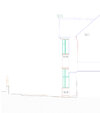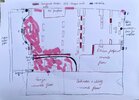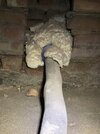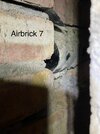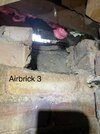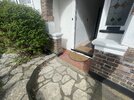Hi
I’m trying to combat damp under my floor as it sometimes smells musty in the house.
House: 1930s semi. Street level higher than house.
History: MDPE moled to replace lead pipe in 2020. Renovation 2021, including UFH.
Houses nearby get water in suspended floors. During renovation we found almost a foot of water. Builders reinstated a subfloor drain and water company repaired a cracked surface water drain and gully running along the back of the house.
Current issue: house sometimes smells musty near the stairs. This happens here because the only area without screed for UFH is in the cupboard under the stairs. I’ve used this to get in the crawl space and made the map attached and some photographs.
The duplicate photo shows where it is wet. The area by the bay is wet. The area by the front door where the MDPE pipe comes in is very wet. Some joists were replaced as were rotten during the 2021 reno.
ground levels: Outside ground levels are too high. I have dug a trench around the bay. I have taken some pictures. So far it has not filled with water.

DPC: the bay does not have a DPC but the walls around and the sleeper walls that also form a kind of cavity by the bay, have a DPC which is about level with the bottom of the concrete plinth.
please can I have some advice on how to get this area to be dry.
Ventilation has definitely been affected for the worse by the 1950s addition of the garage and the recent renovation. There should be at least two extra air bricks where the bathroom is. And airbrick 7 directs almost directly onto a brick.
But the house (and surrounding houses) having water issues is also a problem. It is too wet under there.
Questions:
1) The staggered sleeper walls in the middle which hold wall plates…would removing more bricks help to cross ventilate?
2) The insulated MDPE is on the floor. It is wet inside and outside of the lagging. Is this normal? How can I fix this?
3) Is surface water leaking through the entry point of the water pipe? Or is the pipe leaking? Anything to be done?
4) Is reducing front ground levels worthwhile? How can it help with this?
Any other ideas?
Thanks

I’m trying to combat damp under my floor as it sometimes smells musty in the house.
House: 1930s semi. Street level higher than house.
History: MDPE moled to replace lead pipe in 2020. Renovation 2021, including UFH.
Houses nearby get water in suspended floors. During renovation we found almost a foot of water. Builders reinstated a subfloor drain and water company repaired a cracked surface water drain and gully running along the back of the house.
Current issue: house sometimes smells musty near the stairs. This happens here because the only area without screed for UFH is in the cupboard under the stairs. I’ve used this to get in the crawl space and made the map attached and some photographs.
The duplicate photo shows where it is wet. The area by the bay is wet. The area by the front door where the MDPE pipe comes in is very wet. Some joists were replaced as were rotten during the 2021 reno.
ground levels: Outside ground levels are too high. I have dug a trench around the bay. I have taken some pictures. So far it has not filled with water.
DPC: the bay does not have a DPC but the walls around and the sleeper walls that also form a kind of cavity by the bay, have a DPC which is about level with the bottom of the concrete plinth.
please can I have some advice on how to get this area to be dry.
Ventilation has definitely been affected for the worse by the 1950s addition of the garage and the recent renovation. There should be at least two extra air bricks where the bathroom is. And airbrick 7 directs almost directly onto a brick.
But the house (and surrounding houses) having water issues is also a problem. It is too wet under there.
Questions:
1) The staggered sleeper walls in the middle which hold wall plates…would removing more bricks help to cross ventilate?
2) The insulated MDPE is on the floor. It is wet inside and outside of the lagging. Is this normal? How can I fix this?
3) Is surface water leaking through the entry point of the water pipe? Or is the pipe leaking? Anything to be done?
4) Is reducing front ground levels worthwhile? How can it help with this?
Any other ideas?
Thanks


